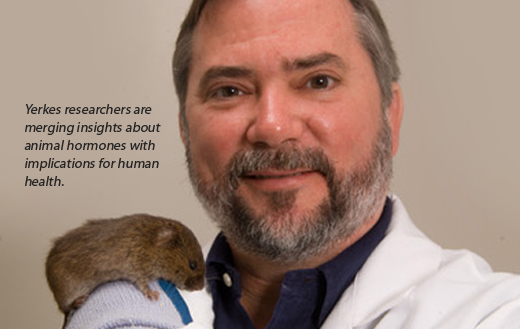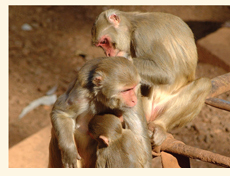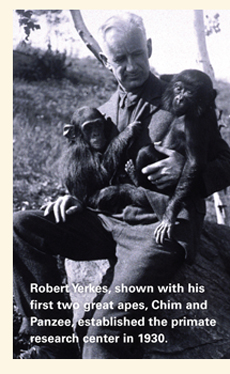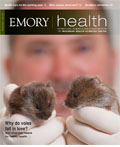Coupling

by Sylvia Wrobel
What does love—or at least monogamy—have to do with autism, schizophrenia, and other conditions with deficits in social awareness and attachment? Larry Young believes his quirky little prairie voles hold some answers.
Once mating is over, fidelity does not come naturally to the vast majority of species. Even within species whose members do engage in social bonding, like humans, some individuals are better at it than others.
In the 1990s, Young (William P. Timmie Professor of Psychiatry at Emory and chief of behavioral neuroscience at Yerkes National Primate Research Center) and Tom Insel (then director of Yerkes and now director of the National Institute of Mental Health) created a scientific and media storm when they reported that the surprisingly ubiquitous and long-lasting monogamy exhibited by a species of voles is attributable to hormones. The popular question was, “Why do voles fall in love?” The answer, said the scientists, was that oxytocin—the same hormone released during labor, delivery, and breast feeding in humans and that promotes mother-infant bonding—creates the female prairie vole’s lifelong attachment to her male partner. A related hormone, vasopressin, causes the male prairie vole to cling to the female with whom he has just had sex, forsaking all others as long as they both shall live.
But the story is not so romantic for all voles. Unlike the highly social, monogamous, and shared-parenting prairie voles, meadow voles couldn’t care less about past sexual partners or, for that matter, pretty much any other animal in the colony. Meadow voles are solitary and promiscuous. Males are uninvolved and seemingly unaware of their offspring.
In a finding that could have interesting implications for humans, Young next discovered that the chief difference between the two species centers on the number and location of neuroreceptors that select, bind, and respond to oxytocin and vasopressin. While both species of voles have these receptors, the prairie voles’ receptors are concentrated in the brain’s pleasure regions, the same regions involved in addiction. Young believes that activation of these receptors during mating leads to a kind of addiction to the partner.
A male meadow vole, on the other hand, is more likely to respond to vasopressin with territorial behavior. Unless, that is, a vasopressin receptor gene is inserted into the pleasure region of the meadow vole’s brain. This single change converts the promiscuous meadow vole into an animal capable of forming strong social bonds, beginning with the female placed in his cage. Conversely, blocking the vasopressin receptor in the brain of a prairie vole is sufficient to prevent such attachments. Hormonally and behaviorally, the once faithful prairie vole is turned into a cad.
In nature, the production of these hormones occurs in response to events like birth or sex. But remember the beauteous queen in A Midsummer Night’s Dream, who becomes besmitten with the cloddish, donkey-headed Bottom the Weaver after she consumes a love potion designed to make her fall for the first creature she sees? When Young gives a female prairie vole a dose of oxytocin or a male a dose of vasopressin, the animal bonds on sight with the nearest potential mate, even before mating occurs.
Young believes similar processes are going on in the human brain, which also contains oxytocin and vasopressin receptors. Previous studies conducted at other institutions have shown that sniffing oxytocin (pills would not make it past the blood-brain barrier) causes the human brain to pay more attention to the fine details of social signals. Eye contact increases. Individuals become better at deciphering emotions from facial expressions and body movements, more likely to remember faces as being familiar, even more likely to trust.
One predictable response to this research was the sudden availability of pricy oxytocin sprays designed for dating, business meetings, or other situations in which a little instant bonding might come in handy. Someday, maybe, shrugs Young. What compels him, he says, is what these discoveries may say about autism, schizophrenia, and other disorders characterized by deficits in social engagement.
We know, he says, that variations in the gene for vasopressin can predict whether a person will be generous, altruistic—even, according to a Swedish study, more likely to marry or report satisfaction with relationships. What role might these genetic variations play in human disorders—and what could be done to compensate for them?
For example, the best treatment now available for autism is behavioral therapy focused on social stimulation. Could oxytocin help people with autism be more receptive to social interaction? Psychosis symptoms in schizophrenia can be treated, but patients often are left with social deficits, for which there is no current treatment. Could oxytocin activate the social part of the brain in these people?
Young recently took two major steps to garner more information from his hamster-sized rodents. First, he and a colleague convinced the NIH to sequence the vole genome within the next two years, a move that will accelerate the discovery of genes contributing to social function.
Second, the Yerkes collaborators developed the first transgenic voles, a technology that allows them to manipulate individual genes to understand their effect on social bonding and other complex social behaviors. Eventually, he believes the model could be used to improve social cognition.
The next step will be to apply the discoveries made in voles to non-human primates, whose brain function is more similar to that of humans. Young already is working with other Yerkes investigators to examine the role of oxytocin and vasopressin in non-human primate social behavior.

Mark Wilson
Pass the Ben and Jerry's
Living at the bottom of the colony’s social hierarchy, the somewhat scrawny female monkeys were always stressed. What they did when Mark Wilson and his team replaced monkey chow with high-fat, high-sugar foods—and how they behaved when the yummy stuff was taken away—may offer clues as to why people overeat.
In compounds at the Yerkes field station, as in natural forest habitats, a strong unyielding hierarchy of dominance governs rhesus macaque monkeys. It takes work to maintain a place at the top. Subordinate animals—subject to continual harassment and continually vigilant for threats of aggression—experience constant psychological stress, evident in elevated levels of stress hormones and anxious behaviors. The research of Yerkes neuroscientist Mark Wilson involves “watching what these magnificent animals do to each other naturally and learning the mechanisms through which subordination impacts their health—and ours.”
One of Wilson’s ongoing studies asks why subordinate female rhesus monkeys go through puberty later than the offspring of more dominant females. He wants to understand how this delay affects brain development and behavior and why these subordinates ovulate less often and have fewer offspring. Wilson believes the work is directly translatable to human patients seen by his research collaborator, Emory chair of OB/Gyn Sarah Berga, a leading expert on stress-induced failure to ovulate.
 The increase [in food intake] suggests that the subordinate animals’ set point had changed, as did their view of food as something to alleviate their chronic stress and make them feel better. |
||
The aspect of this work that may have the largest implication for humans is not infertility, however, but obesity. Concerns of what, when, and why subordinate female rhesus monkeys eat compared with the eating behavior of dominant monkeys hold important clues for human overeating.
Ordinarily, the macaque colony at the Yerkes field station forages from a common feeding tray filled with low-fat monkey chow, fruits, and vegetables. Even though there is plenty (and dominant monkeys do not appear to protect the food), subordinate monkeys generally weigh less.
Finding out why required development of an elaborate automated feeding system. Instead of an open feeding tray, the 50 females selected for Wilson’s eating study had to reach into a bin for food. A remote computer recorded each monkey’s individual microchip number and how much she took.
The subordinate monkeys’ lower weight was quickly explained. As long as the diet consisted of standard monkey chow, the subordinates simply failed to eat as much as those in the dominant group. However, when Wilson substituted the low-fat chow with high-fat, high-sugar chow, the subordinate’s behavior changed. The subordinate monkeys began to eat more—and more, and more. The dominant monkeys, on the other hand, adjusted their consumption to their usual daily caloric intake. When daylight ended, the dominant monkeys quit eating and retreated indoors. The subordinate monkeys continued to reach into the bins.
Interestingly, the subordinates’ mounting weight had no effect on their social status, but it did substantially increase their levels of fat-derived hormones. Had this diet continued, those hormones, combined with existing high levels of the stress hormone cortisol, would almost certainly have caused the new fat to settle around abdominal organs, increasing the risk for diabetes and other metabolic problems—just as in people.
That scenario, however, didn’t develop because after three weeks, the researchers switched the available chow back to the lower-fat version. That’s when things got really interesting. Having no access to the high-caloric chow caused the subordinate monkeys to become even more emotional and anxious when confronted with a stressful situation (for example, when an unfamiliar human intruder stared at them, something monkeys hate). Astonishingly, the subordinate monkeys now ate the low-fat monkey chow in large quantities, much more than the dominant monkeys, far more than they themselves ate before having been introduced to the high-caloric chow.
Wilson says the increase suggests that the subordinate animals’ set point had changed, as did their view of food—any food—as something to alleviate their chronic stress and make them feel better.
The findings parallel work at Wake Forest’s primate center in which subordinate rhesus monkeys self-administer more cocaine than dominant ones. Wilson believes stress related to subordination diminishes the animals’ ability to find rewards in natural stimuli, causing them to seek out other things to increase activity in the brain’s reward pathways. He is now collaborating with another Yerkes researcher in the neuro-imaging center to literally watch what happens to the reward pathways in the brains of the subordinate animals when they eat high-fat, high-sugar foods.

Kim Wallen
What women want
Sigmund Freud complained that he couldn’t figure it out. But when it comes to when to have sex or other matters, Yerkes neuroendocrinologist Kim Wallen knows what gets females’ interest.
Rhesus macaque monkeys—similar to people in many ways but with shorter developmental cycles—offer Wallen the ability to change experimental variables to better understand how hormones affect gender differences in cognition and behavior.
The Yerkes field station houses rhesus monkeys in social groups of 50 or more, allowing the colony to establish social structures and relationships similar to those in nature. That makes a big difference in understanding sexual behaviors, as does the ability to conduct precise physiologic studies in living animals.
Older observational studies of a pair of male and female rhesus monkeys placed together in a cage seemed to indicate that males wanted sex and females went along. In the natural setting, however, that’s not the way it works.
Yes, males may be consistently interested, but females are the ones who initiate sex. If they don’t initiate it, it doesn’t happen. What motivates a female has less to do with the male’s personal appeal or status than what her hormones are saying. It’s true that, as seasonal breeders, rhesus females may be interested in sex only three to five months each year (when they can become pregnant). But it is curious that they remain interested in sex even after they become rhesus senior citizens of 20 or 25. Wallen and his team study which hormones regulate sexual motivation, the results of which they believe will lead to better understanding of the lack or loss of sexual desire in some women, especially after menopause.
Another gender study in monkeys by Wallen and other Yerkes researchers looked at toy preferences of male and female macaques. As any human parent might have predicted, the 11 young rhesus males in the study never hesitated when given a choice between plush doll-like toys or ones with wheels. The 23 females, however, were far less constrained in their preferences, playing almost equally with plush and action toys.
Wallen says the males’ strong, stereotypical preference for action toys parallels the action-packed way they play, just as the 23 young females’ greater interest in the plush toys parallels their greater interest in real infants. Such preference differences are unlikely to have occurred through socialization (monkeys don’t watch ads or suffer teasing from their playmates). Instead they may reflect permanent changes in preference resulting from the hormones they were exposed to in their mother’s womb. EH
|
||


 Yerkes at a glance
Yerkes at a glance